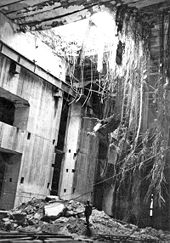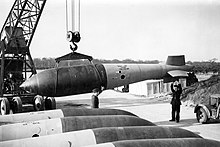Bunker-breaking weapon

Bunker-breaking weapons ( English bunker buster ) are weapons to destroy bunkers . Today it is mostly bombs dropped from airplanes or special guided missiles. When airplanes did not yet have the appropriate lifting capacity, only ground-based systems could be used for this task.
history
First World War
As more and more extensive and better fortifications were built at the end of the 19th century and at the beginning of the 20th century, various states began to develop weapons that were intended to destroy these bunker systems. The most famous of these weapons was the 42 cm " Big Bertha " mortar . Against the majority of the fortifications, such as that of Liège , already outdated at the beginning of the First World War , these guns achieved great success. Because normal HE shells were still used as ammunition , these weapons are neither to be regarded as specialized bunker-breaking weapons nor could they destroy the most modern fortifications at the time, such as in Verdun . From the middle of 1915 onwards, special grenades were developed for these superheavy guns and also for the railway guns . These were given an extra hardened steel casing and were fitted with time fuses. The projectiles were supposed to penetrate deep into the concrete of the bunkers and fortresses fired at and destroy the bunker systems with their enormous explosive effect.
Second World War
In the 1930s, the idea of large guns as weapons against fortifications was taken up again. Through the use of even larger calibers and special bullets, the penetration performance could be massively increased. The projectiles received a tip made from a special steel alloy. Thanks to these improvements, the 60 cm "Karl" mortar was able to penetrate 2.5 meters of concrete, compared to just one meter on the "Dicken Bertha". The shells from the 80 cm “Dora” cannon could even penetrate seven meters of concrete. The military use of these guns is considered to be minor, since the logistical and personnel expenditure was enormous and the accuracy of the hit was low.
The Englishman Barnes Wallis pursued a completely different concept with the “Tallboy” and “Grand Slam” bombs that he constructed during the Second World War . Thanks to its aerodynamic shape, the first developed “Tallboy” reached speeds of over Mach 1. Combined with its great weight of 5.4 tons and a housing made of specially hardened steel , it should be able to penetrate deep into earth and concrete. Against the most heavily armored German submarine bunkers, this was by no means sufficient, which led to the development of the "Grand Slam", which weighs almost twice as much at 10 tons. Thrown from a great height, this could penetrate up to 40 meters into the earth or penetrate up to 4.5 meters of concrete. Due to their success against the German submarine bunkers, these weapons were the first specialized bunker-breaking weapons with an actual military use.
post war period
During the Second Gulf War against Iraq in 1990 ("Operation Desert Storm"), the US military reported an urgent need for a new weapon that should be able to destroy the most heavily armored Iraqi bunkers. In the record time of just one month, the "Texas Instruments Defense Systems and Electronic Group" (now part of the defense company " Raytheon ") developed the GBU-28 , a laser-guided bunker-breaking weapon weighing 2132 kg and from old 203 mm howitzer tubes an explosive filling of 286 kg. In the only two missions of these weapons during the war by US F-111F fighter-bombers, heavily fortified bunkers in Baghdad were destroyed shortly before the end of the fighting. From the experiences during this war, a whole range of different bunker-breaking weapons arose in the USA, some of which were also exported to other countries.
Modern bunker-breaking weapons
How airborne systems work
Today's bunker-breaking weapons still work very similarly to the first "Bunker-Buster" from World War II. The weapons are dropped from a great height, reach a high speed in free fall and have a specially hardened steel housing so that they can penetrate the target surface. The drop height has changed because today's jet aircraft can fly much higher than aircraft with piston engines . In addition, almost all systems today are equipped with GPS or laser guidance in order to increase the accuracy of the hit. Another option is to mount the penetrator on a cruise missile instead of dropping it as a bomb, thereby massively increasing the range. This has the advantage that the weapon platform does not even have to approach the target and is thus protected from the enemy's air defense systems.
The latest development in the field of bunker-breaking weapons is the combination of an ordinary penetrator with a shaped charge attached in front of it . This significantly increases the penetration rate, especially with concrete.
How land-based systems work
In the case of land-based bunker-breaking systems, an existing bazooka or anti-tank guided weapon is used and modified for the new purpose. Modern anti-tank systems usually have a tandem shaped charge , the first overcoming the reactive armor and the second penetrating the actual armor . To convert it into an anti-bunker weapon, the second shaped charge is replaced by a penetrator. The shaped charge shoots a first hole in the bunker, the penetrator makes its way through the remaining structure and detonates the explosive charge within the target.
List of modern bunker-breaking weapons
United States
- Weapons with conventional warheads
- BLU-109 : Penetrator with Paveway or JDAM steering kits. With a weight of 863 kg, it has a penetration capacity of 1.8 meters of concrete.
- BLU-113 : With a weight of 2270 kg one of the strongest penetrators in the world. It can only be equipped with special steering sets and cuts through around six meters of concrete.
- BLU-116 : Further development of the BLU-109 penetrator, which can be used with Paveway or JDAM steering sets. It is similar in size and weight to the BLU-109 and penetrated 3.4 meters of concrete in tests.
- BLU-118 : New type of penetrator that can be used with Paveway or JDAM steering sets. Instead of conventional explosives, it is equipped with a thermobaric warhead that can shut down bunkers without direct penetration. Weight about 900 kg.
- BLU-122 : Greatly improved, similarly heavy and large version of the BLU-113 penetrator. Penetrates more than 7 meters of concrete.
- BLU-137 : Successor to the BLU-109 with an improved detonator.
- Small Diameter Bomb (SDB): Despite its small size and mass (around 114 kg), the SDB has the same penetration capacity as the BLU-109. However, the warhead is much smaller, which is why the SDB will not replace the BLU-109. The long-term aim of the program is to replace the larger Mk. 84 bombs in order to be able to transport more weapons per aircraft with the same payload.
- Massive Ordnance Penetrator (MOP): 13.6 ton bomb for use against extremely heavily bunkered targets. Should penetrate up to 60 meters of concrete.
- Nuclear warhead weapons
Russia
- KAB-1500LG: Glide bomb with laser homing. Penetration performance around 20 meters of earth or two meters of concrete.
- KAB-1500LF: Glide bomb with laser targeting. Penetration performance of 20 meters of soil or four meters of concrete.
- KAB-1500Kr: Glide bomb with optical CCD seeker head . Penetration performance like KAB-1500LF.
Europe
- BROACH: A British - French penetrator with an additional shaped charge, which was developed for the cruise missile "Storm Shadow" . BROACH can penetrate up to four meters of concrete.
- MEPHISTO : A double charge penetrator weighing almost 500 kg, which was developed in Germany for the Taurus cruise missile. The penetration rate here is also several meters of reinforced concrete.
Trivia
The following passage from the novel Heeresbericht by Edlef Köppen describes in detail the effect of such grenades, as Erich Maria Remarque had met them:
“ The 7.5 cm shells of the light field artillery, which weigh 5.6 kg and have an explosive charge of 0.608 kg, penetrate 1.80 meters into the earth, 12 centimeters into concrete, have a total force of impact and explosion from 230 meters and fling 508 splinters around. - The penetration depth of an impacting 15-centimeter projectile in the earth is 4.10 meters, in concrete 39 cm, the explosive charge weighs 4.86 kilograms, the force of the explosive charge 1,900 meters, the number of fragments is 2030. - One 30.5-cm -The bullet weighs 324 kilograms, develops an explosive force that is comparable to an express train of 50 cars at 85 kilometers per hour, hurls 8110 splinters around and penetrates 8.10 meters into the earth and 90 centimeters into concrete. "
Edlef Köppen used the book by Friedrich Stuhlbach, Der Stellungskrieg , p. 260 for his report . The Stuhlbach report is very authentic because it dates back to 1912.
literature
- Edlef Köppen : Army report . 2nd Edition. Verlag der Nation, Berlin 1985, p. 218.
Web links
- The British Grand Slam Bomb ( July 6, 2007 Memento )
- The GBU-28 ( Memento from March 15, 2017 in the Internet Archive ) (English)
- Report on the possible use of bunker breaker technology in lunar research ( Memento from January 17, 2017 in the Internet Archive )
- Paveway Laser Guided Bombs ( Memento from October 20, 2006 in the Internet Archive ) (English; PDF; 241 kB)
- New BLU-116 bunker crusher against hard targets ( Memento from January 7, 2017 in the Internet Archive )
- The free-falling bunker-breaking nuclear weapon B61-11 ( Memento from July 21, 2017 in the Internet Archive ) (English)
Individual evidence
- ↑ Archive link ( Memento from July 24, 2017 in the Internet Archive ) Development program "SDB" to reduce the size of free-fall bombs with the same effective power (English)
- ^ Edlef Köppen: Army report . Verlag der Nation, Berlin 1985, 2nd edition, p. 218


